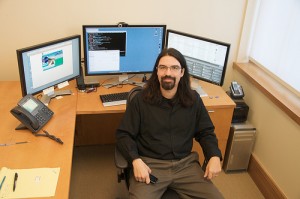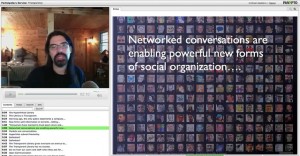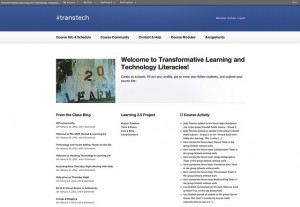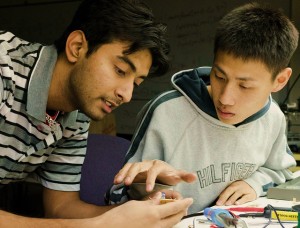
Dr. Michael Stephens (SLIS image)
By Dr. Michael Stephens, Assistant Professor, School of Library and Information Science
(Editor’s note: The sage on the stage in giant lecture halls is giving way to a collaborative, hyperconnected world. SJSU’s School of Library and Information Science is at the forefront of online learning. We asked an instructor to share his experiences. You can also read more from a student’s perspective.)
I’ve been teaching online and hybrid courses for a few years, but joining SJSU’s School of Library and Information Science (SLIS) last summer led to full time, fully online teaching. Some dismiss online classes as ineffective, text-based “correspondence” style endeavors. I believe it all depends on the caliber of the online experience. Are the classes just ported over from face-to-face syllabi and entirely text-based? Or do they transform learning and inspire students?
I was drawn to online instruction because of the potential for using interactive technologies and social tools to extend my “classroom” beyond four walls and immerse my students in the environments they’ll encounter in future jobs. I teach courses that explore new service models in libraries, as well as transformative learning, where I encourage my students to design instructional programs using emerging technologies.
Over the past few years, I’ve worked on creating a learning environment that fosters rich interaction between students and me, and gets students interacting with each other. I prefer not to keep our work and interactions inside the “walled garden” of a closed learning management system (LMS), but out on the open Web. Our students will surely be called upon to communicate online to some degree with the people they serve. Having an understanding of interaction outside the safe confines of an LMS is important.
Utilizing the open source content management system WordPress and a suite of plug ins called Buddypress, I create a “social network” for learning that features blogs for all students, a course activity feed, forums, work groups, and integration of other social tools. My class size is usually 25 or so students. Each student gets an account and blog within the site and can customize their environment with widgets, themes and add ons. Small images represent each student – some use a photo, others choose to use avatars.

Panopto combines slides, text and video into a rich, media-based Web experience (SLIS image).
Transforming learning while inspiring students
SLIS provides access to some cutting edge tools to deliver class content. I use Panopto to record lectures. Panopto combines slides, text and video into a rich, media-based Web experience. (See screenshot to see it in action.) Feedback from students has been positive. I advocate for the use of video in online teaching as a means to share beyond just text. Teaching summer sessions at my previous position, I often recorded short video “shout outs” to my class from the hiking trail or beside a lake in northern Michigan. Letting them see a bit of my world, of my experience, reinforces the connection I believe is so important to establish. Last fall, I recorded a series of lectures with my trusty Labrador Cooper sleeping nearby within the frame. Other videos I record with my iPhone or Flip for upload to YouTube. These can be easily embedded into the course site and shared.
Other tools allow us to create a sense of connection and community. This is important to me as an online educator. We utilize Blackboard Collaborate to have weekly live video conference sessions. I’ve dubbed them the Commons, a place where each participant adds value to the experience. One week we might have an open discussion or office hours style meet up, and other sessions might include a guest speaker. Recordings of these interactions are posted to my course sites as soon as we wrap up, for those who cannot attend the live session. It’s not out of the ordinary for a student to stop into the online room just to say hello and make a quick comment.
As a companion to the online meeting space, we use Blackboard Instant Messaging (IM), an application that allows faculty, staff and students to log in and interact in similar fashion to other chat programs. While working each day, I log in and set my status to available. Students and my colleagues at SLIS can send a brief question or comment via IM and I can do the same. The application seamlessly integrates with Collaborate and allows groups to break out into rooms for further collaboration. Each semester, the application automatically populates with my class lists. For students, it’s comforting to know that a professor is just a few keyboard taps away in the online environment.
I also use the micro-blogging site Twitter for sharing with my students and promoting conversation. We utilize Twitter hashtags to associate and share our tweets, and library practitioners can share and participate as well. Students use devices other than a personal computer to interact via Twitter, and on the course site. On the go and from anywhere, my students can share or participate via their smartphone or tablet. Posting a picture, a link or just a brief thought about class content can happen anywhere.

In Transformative Learning and New Literacies, students create web-based, self-directed learning programs for library staff (SLIS image).
Interactive learning environments encourage experimentation
The world is changing faster than ever, and the skillsets needed by SJSU students in the School of Library and Information Science are rapidly evolving. Students need to learn how to incorporate emerging technology into their future roles in libraries and information centers. As I teach courses in the School’s fully online graduate program, I’m well aware of the need to create an engaging, interactive learning environment for my students that prepares them for tomorrow challenges.
I believe a focus on play and experimentation is needed for 21st century learning success. These newer forms of learning – play and experimentation – can prepare students for the world they will work in after they graduate, and for years to come.
I emphasize this focus on experimentation via the assignments in my online courses. In my class called The Hyperlinked Library and Emerging Technologies, students create media-based reports on recent books related to society and culture. Any media platform or 2.0 tool that can be shared across the web is fair game for play and experimenting for this assignment.
In Transformative Learning and New Literacies, my students create web-based, self-directed learning programs for library staff, replicating a similar environment to our course community. Experience with content management systems and various tools for creating online learning modules put them in the thick of what it will be like to do the same in their future work. Later, they each design an online component to their own personal learning networks and articulate the steps they took to build it, as well as what potential problems or issues it may help them solve as new information professionals.
Communication is key in online teaching
I have a plaque in my home office that quotes Michaelangelo, “I am still learning.” I keep that in mind as I reflect on my own teaching and use of technology. It’s an ongoing process to continue to improve. I learn from my students, my colleagues and from the networks I participate in online. It’s fine to say “I don’t know” about the next new thing and explore it with previous learning in mind. I want this for my students as well. Skills they develop now – exploring a new tool, creating new knowledge, making connections with others – will serve them well in their careers.
I’ve also learned not to get hung up on perfection. A mistake or two in a lecture or stumbling over words in a video does not negate the experience for students. In fact, it helps counteract the “culture of perfect” that sometimes permeates libraries and other environments. “Everything is beta” is a popular way to describe this approach.
Communication is key to successful online teaching as well. Being present on the course site and answering questions directed to me are a given, but I also work at consistent updating. If I’m traveling to speak at a library or conference, I let my students know. If I’m at a conference, I’ll share links and insights. My students have done the same, using Twitter or their class blogs to share their own opinions and takeaways from attending professional conferences. The sharing and communication can be informal, and it strengthens the feeling of community.
The best teachers understand that technology use in coursework is not just for the sake of technology but to extend and enhance the learning process. Recently, Michael Wesch from the University of Kansas responded to an article about his advocacy for participatory technologies in coursework. His eloquent statement resonates with me: “My main point is that participatory teaching methods simply will not work if they do not begin with a deep bond between teacher and student. Importantly, this bond must be built through mutual respect, care, and an ongoing effort to know and understand one another.”
The sage on the stage in giant lecture halls is giving way to a collaborative, hyperconnected world of newer methods and channels of learning, but the human connection can and should remain. Bring yourself to your online teaching – share, be authentic and connect with students via the heart and the keyboard.






